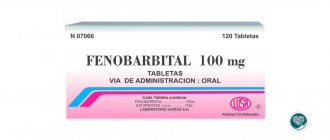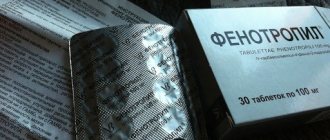Olanzapine
Hyperglycemia and diabetes mellitus
There is a higher prevalence of diabetes mellitus in patients with schizophrenia. There are very rare reports of the development of hyperglycemia and/or decompensation of diabetes mellitus, sometimes accompanied by the development of ketoacidosis or ketoacidotic coma, including reports of several fatal cases. In some cases, there was an increase in body weight preceding decompensation, which could become a predisposing factor. In patients with diabetes mellitus and risk factors for the development of this disease, regular clinical monitoring and monitoring of blood glucose concentrations is recommended.
Change in lipid concentration
During therapy with olanzapine, it is necessary to monitor plasma lipid concentrations in patients with dyslipidemia and in patients with risk factors for lipid metabolic disorders. Patients taking olanzapine therapy need to monitor their lipid profile. If lipid concentrations change, therapy adjustments are required.
Anticholinergic activity
In clinical studies, olanzapine therapy was rarely accompanied by adverse reactions due to blockade of M-cholinergic receptors. Because clinical experience with olanzapine in people with underlying medical conditions is limited, the drug should be used with caution in patients with clinically significant prostatic hyperplasia, paralytic ileus, angle-closure glaucoma, and similar conditions.
Use of olanzapine in patients with Parkinson's disease
Olanzapine is not recommended for the treatment of psychosis caused by dopaminomimetics in Parkinson's disease. Symptoms of parkinsonism and hallucinations increase. However, olanzapine was not superior to placebo in treating psychosis.
Dopaminergic antagonism
In vitro
Olanzapine exhibits dopamine receptor antagonism and, like other antipsychotics (neuroleptics), may theoretically inhibit the action of levodopa and other dopamine receptor agonists.
Experience with olanzapine in elderly patients with dementia-related psychosis. The effectiveness of olanzapine in elderly patients with dementia-related psychosis has not been established. In placebo-controlled clinical trials (lasting 6-12 weeks) in elderly patients (mean age 78 years) with psychosis and behavioral disturbances due to dementia, there was an increase in deaths in patients treated with olanzapine compared with placebo ( 3.5% versus 1.5% respectively). The increase in mortality was independent of the olanzapine dose or duration of therapy. Risk factors predisposing to increased mortality include: age over 75 years, dysphagia, sedation, malnutrition and dehydration, lung diseases (for example, pneumonia, including aspiration), concomitant use of benzodiazepines.
Cerebrovascular adverse events including stroke in elderly patients with dementia
Cerebrovascular adverse events (stroke, transient ischemic attack), including deaths, were observed in studies of olanzapine in elderly patients with psychosis associated with dementia. In placebo-controlled studies, there was a higher incidence of cerebrovascular adverse events in patients in the olanzapine group compared with the placebo group (1.3% versus 0.4%, respectively). All patients had previous risk factors for cerebrovascular adverse events (smoking, hypertension, previous cerebrovascular adverse event or transient ischemic attack), as well as concomitant diseases with medications temporally associated with cerebrovascular adverse events.
Postural hypotension
Postural hypotension was not frequently observed in elderly patients during clinical trials of olanzapine. As with other antipsychotic drugs, periodic monitoring of blood pressure is recommended in patients over 65 years of age.
QT interval
In clinical studies, clinically significant QT prolongation (QT interval correction [QTcF] ≥500 milliseconds in patients with baseline QTcF <500 msec) was rarely observed (0.1%-1%) in patients receiving olanzapine therapy for against the background of no significant differences with placebo in terms of associated cardiac events. However, as with other antipsychotic drugs, caution should be exercised when prescribing olanzapine concomitantly with drugs that can prolong the QT interval, especially in elderly patients, patients with long QT syndrome, congestive heart failure, cardiac hypertrophy, hypokalemia or hypomagnesemia. Electrocardiogram monitoring should be performed during olanzapine therapy.
Liver dysfunction
At the beginning of therapy, an asymptomatic increase in the activity of liver transaminases (ALT and AST) in the blood serum is often observed. Rare cases of hepatitis have been reported. In addition, there have been isolated reports of cholestatic and mixed liver damage. In patients with initially elevated serum AST and/or ALT levels, patients with liver failure and conditions that potentially limit liver function, and those taking hepatotoxic drugs, special caution should be exercised when prescribing olanzapine. If ALT and/or AST increase during drug therapy, medical monitoring of the patient and, possibly, a reduction in the dose of the drug are recommended. If hepatitis (including hepatocellular, cholestatic or mixed) is diagnosed, olanzapine should be discontinued.
Hematological changes
The drug should be used with caution in patients with leukopenia and/or neutropenia of any origin, myelosuppression of drug origin, as well as during radiation or chemotherapy, due to concomitant diseases, in patients with hypereosinophilic conditions or myeloproliferative diseases. Neutropenia was often observed with simultaneous use of olanzapine and valproic acid (see section "Side effects").
Neuroleptic malignant syndrome (NMS)
NMS is a potentially life-threatening condition associated with treatment with antipsychotic drugs (neuroleptics), incl. olanzapine. Clinical manifestations of NMS: fever, muscle rigidity, impaired consciousness, autonomic disorders (unstable pulse or labile blood pressure, tachycardia, increased sweating, arrhythmias).
Additional symptoms of NMS: increased CPK, myoglobinuria (against the background of rhabdomyolysis) and acute renal failure. If symptoms of NMS develop, as well as an increase in body temperature for no apparent reason, it is necessary to discontinue all antipsychotics, incl. olanzapine.
Convulsive syndrome
Olanzapine should be used cautiously in patients with a history of seizures or risk factors that lower the seizure threshold. Seizures were rarely reported while taking olanzapine.
Tardive dyskinesia
In comparative studies, olanzapine therapy was significantly less likely to be accompanied by the incidence of tardive dyskinesia requiring drug correction than the use of typical and other atypical antipsychotics. The risk of developing tardive dyskinesia increases with increasing duration of therapy. If signs of tardive dyskinesia develop in a patient taking olanzapine, dose adjustment is recommended. Symptoms of dyskinesia may temporarily increase after discontinuation of the drug.
General activity in relation to the central nervous system
Caution should be exercised when using olanzapine and other centrally acting drugs simultaneously and avoid alcohol consumption.
Thromboembolism
Cases of venous thromboembolism have been reported very rarely (less than 0.01%) when taking olanzapine. A cause-and-effect relationship between olanzapine therapy and venous thrombosis has not been established. Because patients with schizophrenia often have acquired risk factors for venous thrombosis, all possible other factors (eg, immobilization) should be identified and preventive measures taken.
Sudden death
Clinical experience with all antipsychotics, including olanzapine, has shown a similar dose-dependent increase in the risk of sudden death due to acute heart failure. In a retrospective observational cohort study, the risk of suspected sudden cardiac death in patients treated with olanzapine was increased approximately twofold compared with patients not using antipsychotics. In the study, the risk for olanzapine was comparable to the risk for the atypical antipsychotics included in the pooled analysis.
Long-term drug therapy
With long-term therapy with olanzapine (up to 12 months), in order to prevent relapses in patients with bipolar disorders, there was an increase in body weight of >7% from the original (in 39.9% of patients). With longer therapy (more than 48 weeks), clinically significant changes were observed - increases in body weight, glucose concentration, total cholesterol/LDL/HDL or triglycerides. In adult patients who completed a 9-12 month course of treatment, an increase in mean blood glucose concentration was observed after approximately 6 months. Patients with risk factors for the development of concomitant diseases who are on long-term therapy with olanzapine need to be monitored by a specialist during the entire course of therapy.
Withdrawal syndrome
When olanzapine is stopped abruptly, very rarely (less than 0.01%) the following symptoms may develop: sweating, insomnia, tremor, anxiety, nausea or vomiting. When discontinuing the drug, a gradual dose reduction is recommended.
Use in children
Olanzapine is not recommended for use in children and adolescents under 18 years of age due to the lack of sufficient data on efficacy and safety. In short-term studies in patients 13 to 17 years of age, more significant increases in body weight and changes in lipid and prolactin concentrations were reported than in similar studies in adults (see section "Side Effects").
Olanzapine-SZ
When treated with neuroleptics, neuroleptic malignant syndrome may develop (hyperthermia, muscle rigidity, changes in mental status, autonomic disorders, including unstable pulse or blood pressure, tachycardia, cardiac arrhythmias, increased sweating; increased CPK activity, myoglobinuria as a result of rhabdomyolysis, acute renal failure).
If clinical manifestations of neuroleptic malignant syndrome are detected (including hyperthermia without other symptoms), discontinuation of olanzapine is required.
If signs of tardive dyskinesia develop, it is recommended to reduce the dose or discontinue olanzapine. Symptoms of tardive dyskinesia may increase or manifest after discontinuation of the drug.
When taking olanzapine (in studies), cerebrovascular disorders (stroke, transient ischemic attack), including deaths, were observed in elderly patients with psychosis due to dementia. These patients had previous risk factors (cerebrovascular disorders (history), transient ischemic attack, arterial hypertension, smoking), as well as concomitant diseases and/or drug intake that were temporally associated with cerebrovascular disorders. Treatment of patients with psychosis associated with dementia is not recommended.
Particular caution is required when increasing the activity of ALT and/or AST in patients with liver failure or receiving treatment with potentially hepatotoxic drugs. Monitoring the patient and, if necessary, reducing the dose is required.
There is a higher prevalence of diabetes mellitus in patients with schizophrenia. Very rarely, cases of hyperglycemia, development of diabetes mellitus or exacerbation of pre-existing diabetes mellitus, ketoacidosis and diabetic coma have been reported. The causal relationship between antipsychotic drugs and these conditions has not been established. Clinical monitoring of patients with diabetes mellitus or with risk factors for its development is recommended.
Should be used with caution: in patients with a history of epileptic seizures or in the presence of factors that reduce the seizure threshold; in patients with a decrease in the number of leukocytes and/or neutrophils, with signs of suppression or toxic impairment of bone marrow function under the influence of drugs (history), with suppression of bone marrow function due to concomitant disease, radio- or chemotherapy (history); with hypereosinophilia or myeloproliferative disease.
The use of olanzapine in patients with clozapine-dependent neutropenia or agranulocytosis (history) was not accompanied by relapses of these disorders.
It is recommended to exercise caution when prescribing olanzapine to patients with symptomatic prostatic hypertrophy, paralytic ileus, and angle-closure glaucoma.
It antagonizes dopamine and, theoretically, can suppress the effects of levodopa and dopamine agonists.
Caution should be exercised when using the drug in combination with other centrally acting drugs and ethanol.
During the treatment period, care must be taken when driving vehicles and engaging in potentially hazardous activities that require increased concentration and speed of psychomotor reactions.
Olanzapine, 5 mg, tablets, 30 pcs.
Suicide
The risk of suicide attempts in patients with schizophrenia and bipolar disorder type 1 is determined by these diseases themselves. In this regard, during pharmacotherapy, careful monitoring of those patients whose risk of suicide is especially high is required. When prescribing olanzapine, efforts should be made to minimize the number of tablets the patient takes to reduce the risk of overdose.
ZNS
NMS (potentially lethal symptom complex) can develop during treatment with any antipsychotics, including olanzapine. Clinical manifestations of NMS include a significant increase in body temperature, muscle rigidity, changes in mental status, and autonomic disturbances (unstable pulse or blood pressure, tachycardia, cardiac arrhythmias, increased sweating). Additional signs may include increased CPK activity, myoglobinuria (rhabdomyolysis), and acute renal failure. Clinical manifestations of NMS or a significant increase in body temperature without other symptoms of NMS require discontinuation of all antipsychotics, including olanzapine.
Tardive dyskinesia
In comparative studies, treatment with olanzapine was significantly less often accompanied by the development of dyskinesia requiring drug correction than the use of typical and other atypical neuroleptics. However, the risk of tardive dyskinesia should be taken into account during long-term therapy with antipsychotics. If signs of tardive dyskinesia develop, dose adjustment of the antipsychotic is recommended. It should be taken into account that when switching to olanzapine, symptoms of tardive dyskinesia may develop as a result of immediate withdrawal of previous therapy. Over time, the intensity of these symptoms may increase; moreover, these symptoms may develop after cessation of therapy.
Experience in elderly patients with dementia-related psychosis
The effectiveness of olanzapine in elderly patients with dementia-related psychosis has not been established. In this category of patients in placebo-controlled clinical trials, the incidence of deaths in the olanzapine group was higher than in the placebo group (3.5 versus 1.5%, respectively). Risk factors that may predispose this group of patients to higher mortality when treated with olanzapine include age >80 years, sedation, concomitant use with benzodiazepines, or the presence of pulmonary pathology (eg, pneumonia with or without aspiration).
There are insufficient data to establish differences in the incidence of cerebrovascular events and/or mortality (compared with placebo) and risk factors in this group of patients between oral and intramuscular olanzapine.
Parkinson's disease
The use of olanzapine is not recommended in the treatment of psychosis induced by dopamine receptor agonists in Parkinson's disease. In clinical studies in patients with dopamine receptor agonist drug-induced psychosis in Parkinson's disease, increased parkinsonian symptoms were very common (≥10%) and at a higher frequency than in the placebo group. Hallucinations were also reported very frequently (≥10%) and at a higher frequency than in the placebo group.
Liver dysfunction
In some cases, taking olanzapine, usually in the early stages of therapy, was accompanied by a transient, asymptomatic increase in the activity of hepatic transaminases (AST and ALT) in the blood serum. Rare cases of hepatitis have been reported. In addition, there have been isolated reports of cholestatic and mixed liver damage. Particular caution is required when increasing the activity of AST and/or ALT in the blood serum in patients with insufficiency of liver function, limited functional reserve of the liver, or in patients receiving treatment with potentially hepatotoxic drugs. If AST and/or ALT activity increases during treatment with olanzapine, careful monitoring of the patient is required and, if necessary, dose reduction. In cases of severe liver dysfunction caused by olanzapine, its use should be discontinued.
Hyperglycemia and diabetes mellitus
There is a higher prevalence of diabetes mellitus in patients with schizophrenia. As with some other antipsychotic drugs, there have been rare cases of hyperglycemia and decompensation of diabetes mellitus, in some cases accompanied by ketoacidosis and diabetic coma, incl. with fatal outcome. Close clinical monitoring of patients with diabetes mellitus and risk factors for developing diabetes mellitus is recommended.
Change in lipid profile
During placebo-controlled studies, undesirable lipid changes were observed in patients receiving olanzapine. Clinical observation is recommended (see "Side effects").
Development of the risk of sudden death
Clinical experience with all antipsychotics, including olanzapine, has shown a similar dose-dependent two-fold increase in the risk of death due to acute heart failure compared with deaths due to acute heart failure in patients not using antipsychotics.
Cerebrovascular adverse events, including stroke, in elderly patients with dementia
Cerebrovascular adverse events (eg, stroke, transient ischemic attack), including deaths, were observed in studies of olanzapine in elderly patients with psychosis associated with dementia. In placebo-controlled studies, there was a higher incidence of cerebrovascular adverse events in patients in the olanzapine group compared with the placebo group (1.3 vs. 0.4%, respectively). All patients with cerebrovascular events had previous risk factors for the development of cerebrovascular adverse events (for example, a previous case of a cerebrovascular adverse event or transient ischemic attack, arterial hypertension, smoking), as well as concomitant diseases and/or medications temporally associated with cerebrovascular adverse events. Olanzapine is not indicated for the treatment of patients with psychosis associated with dementia.
Convulsions
Olanzapine should be used with caution in patients with a history of seizures or exposure to factors that lower the seizure threshold. In such patients, seizures were rarely observed during olanzapine treatment.
M-anticholinergic activity
In clinical studies, olanzapine therapy was rarely accompanied by adverse reactions due to blockade of m-cholinergic receptors. However, clinical experience with olanzapine in patients with comorbidities is limited, and caution is recommended when prescribing olanzapine in patients with clinically significant prostatic hyperplasia, paralytic ileus, angle-closure glaucoma, and similar conditions.
Blockade of dopamine receptors
In vitro
Olanzapine exhibits dopamine receptor antagonism and, like other antipsychotics (neuroleptics), may theoretically inhibit the effects of levodopa and other dopamine receptor agonists.
Hematological changes
Olanzapine should be used with caution in patients with low levels of leukocytes and/or neutrophils in the blood; receiving drugs that can cause neutropenia; with suppression of bone marrow function due to disease, radiation or chemotherapy; as well as patients with eosinophilia and/or myeloproliferative diseases. Neutropenia has been reported primarily when olanzapine is combined with valproate.
In clinical studies, the use of olanzapine in patients with a history of clozapine-dependent neutropenia or agranulocytosis was not accompanied by relapses of these disorders. The development of neutropenia has been reported primarily during concomitant therapy with olanzapine and valproic acid.
QT interval
In clinical trials, clinically significant prolongation of the QT interval (QT interval with Frederick's correction (QTcF) >500 ms in patients with baseline value, QTcF <500 ms) was observed infrequently in patients receiving olanzapine, with no significant differences from placebo in the incidence of adverse events. phenomena from the heart. However, as with other antipsychotics, caution is recommended when using olanzapine in combination with drugs that can prolong the QT interval, especially in elderly patients with congenital prolongation of the QT interval, CHF, myocardial hypertrophy, hypokalemia and hypomagnesemia.
Cancellation of therapy
In case of abrupt discontinuation of olanzapine, acute development of sweating, insomnia, tremor, anxiety, nausea and vomiting has been reported extremely rarely (<0.01%).
Thromboembolism
Very rarely (<0.01%) the development of venous thromboembolism has been reported during olanzapine therapy. The presence of a cause-and-effect relationship between taking olanzapine and venous thromboembolism has not been established. However, given that patients with schizophrenia often have acquired risk factors for venous thromboembolism, it is necessary to conduct a cumulative assessment of all possible risk factors for the development of this complication, incl. immobilize patients and take necessary preventive measures.
General activity in relation to the central nervous system
Given the primary central nervous system effects of olanzapine, caution should be exercised when olanzapine is used in combination with other centrally acting drugs and alcohol.
Postural hypotension
Postural hypotension was observed infrequently in clinical studies of olanzapine in the elderly. As with other antipsychotics, periodic blood pressure monitoring is recommended when olanzapine is used in patients over 65 years of age.
Body mass
During treatment (up to 6 weeks) of the acute phase of schizophrenia, when in placebo-controlled trials of olanzapine, the percentage of patients who experienced a weight gain of ≥7% from baseline, the difference was statistically significant and was 29% in those taking olanzapine and only 3% in the placebo group. The mean weight gain in these patients treated with olanzapine during the acute phase was 2.8 kg. Body mass index (BMI) always increased clinically significantly in the study group. During long-term treatment of schizophrenia with olanzapine, weight gain averaged 5.4 kg; in 56% of patients in the test group, body weight increased by more than 7% from the baseline. For patients undergoing long-term treatment for bipolar disorder, the average weight gain was 3.8 kg, and the number of patients with a weight gain of more than 7% was 31%.
Hyperprolactinemia
In controlled clinical trials (no more than 12 weeks), an increase in prolactin levels in the blood was found in 30% of patients in the test group and 10.5% in the placebo group (control). The levels of increase in prolactin concentrations themselves were moderate. Identified clinical manifestations included: menstrual dysfunction (common), sexual dysfunction (particularly erectile dysfunction in men; decreased or loss of libido in men and women; abnormal orgasm) and breast disorders (uncommon).
Dysphagia
The appearance of esophageal motility disorders and aspiration are associated with the use of antipsychotic drugs. Aspiration pneumonia is a common cause of morbidity and mortality in patients with advanced Alzheimer's disease, requiring caution in these patients.
Body temperature regulation
Antipsychotic drugs are generally credited with interfering with the body's ability to control core body temperature. Appropriate caution should be used in patients taking olanzapine in environments that increase core body temperature. For example, they perform vigorous physical exercise, are exposed to high ambient temperatures, take any drugs with anticholinergic activity together with olanzapine, or are in conditions of dehydration (sweat intensely).
Children and teenagers under 18 years of age
Olanzapine is not recommended for use in children and adolescents under 18 years of age due to the lack of sufficient data on efficacy and safety. In short-term studies that were conducted in adolescents 13–17 years of age, there was a greater increase in body weight and changes in lipid and prolactin concentrations than in similar studies in adults.
Impact on the ability to drive vehicles and operate machinery.
Patients taking olanzapine should be warned about the dangers associated with operating machinery, including motor vehicles, as olanzapine may cause drowsiness and dizziness.








